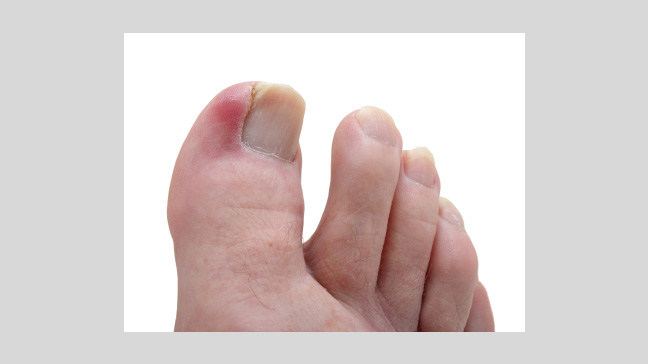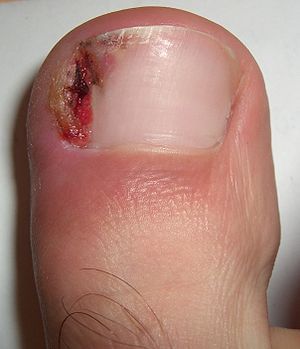All About Ingrown Toenails!
What are ingrown toenails?
 1. Ingrown toenails occur when the edges or corners of the nail grow into the skin next to the nail.
1. Ingrown toenails occur when the edges or corners of the nail grow into the skin next to the nail.
2. Ingrown toenails that are not infected can be treated at home, but you should seek medical treatment if the nail has pierced the skin.
3. You are at a higher risk of complications from an ingrown toenail if you have diabetes or other conditions that cause poor circulation.
Ingrown toenails occur when the edges or corners of your nails grow into the skin next to the nail. Your big toe is most likely to get an ingrown toenail.
What causes ingrown toenails?
Ingrown toenails occur in both men and women. According to the National Health Services (NHS), ingrown toenails may be more common in people with sweaty feet, such as teenagers. Older people may also be at higher risk because toenails thicken with age.
Many things can cause an ingrown toenail, including:
- Cutting toenails incorrectly (cut straight across, since angling the sides of the nail can encourage the nail to grow into the skin)
- Irregular, curved toenails
- Footwear that places a lot of pressure on the big toes, such as socks and stockings that are too tight or shoes that are too tight, narrow, or flat for your feet
- Toenail injury, including stubbing your toe, dropping something heavy on your foot, or kicking a ball repeatedly
- Poor posture
- Improper foot hygiene, such as not keeping your feet clean or dry
- Genetic predisposition
Using your feet extensively during athletic activities can make you especially prone to getting ingrown toenails. Activities in which you repeatedly kick an object or put pressure on your feet for long periods of time can cause toenail damage and increase your risk of ingrown toenails. They include:
- Ballet
- Football
- Kickboxing
- Soccer
What are the symptoms of ingrown toenails?
Ingrown toenails can be painful, and they usually worsen in stages.
Early-stage symptoms include:
- Skin next to the nail becoming tender, swollen, or hard
- Pain when pressure is placed on the toe
- Fluid building up around the toe
If your toe becomes infected, symptoms may include:
- Red, swollen skin
- Pain
- Bleeding
- Oozing pus
- Overgrowth of skin around the toe
How are ingrown toenails diagnosed?
Your doctor will most likely be able to diagnose your toe with a physical exam.
What are the treatment options for ingrown toenails?
Ingrown toenails that aren’t infected can normally be treated at home. However, if your toenail has pierced the skin, or there is any sign of infection, seek medical treatment. Signs of infection include:
- Warmth
- Pus
- Redness and swelling
Home treatment
To treat your ingrown toenail at home, try:
- Soaking your feet in warm water for about 15 to 20 minutes three to four times a day
- Pushing skin away from the toenail edge with a cotton ball soaked in olive oil
- Using over-the-counter medicines, like calpol, for the pain
- Applying a topical antibiotic, such as t-bact, to prevent infection
-
If the toenail does not respond to home treatments or an infection occurs, you may need surgery. In cases of infection, stop all home treatments and see your doctor.
Surgical treatment
Total nail removal may be used if your ingrown nail is caused by thickening. The doctor will give you a local pain injection and then remove the entire nail.
-
According to the NHS, nail removal is 98 percent effective for preventing future ingrown toenails.
After surgeryYour doctor will send you home with your toe bandaged. You will probably need to keep your foot raised for the next one to two days and wear special footwear to allow your toe to heal properly.
Avoid movement as much as possible. Your bandage is usually removed two days after surgery. Your doctor will advise you to wear open-toed shoes and to do daily salt water soaks until your toe heals. You will also be prescribed pain relief medication and antibiotics to prevent infection.
Your toenail will likely grow back a few months after a partial nail removal surgery. If the entire nail is removed down to the base, the nail matrix under your skin, a toenail can take over a year to fully grow back.
Complications of ingrown toenails
If left untreated, an ingrown toenail infection can cause an infection in the bone in your toe. A toenail infection can also lead to foot ulcers, or open sores, and a loss of blood flow to the infected area.
A foot infection can be more serious if you have diabetes.
Preventing ingrown toenails
Trim your toenails straight across and make sure that the edges do not curve in.
- Avoid cutting toenails too short.
- Wear proper fitting shoes, socks, and tights.
- Wear steel-toed boots if you work in hazardous conditions.
-
If your toenails are abnormally curved or thick, surgery may be necessary to prevent ingrown nails.




+1.svg)
